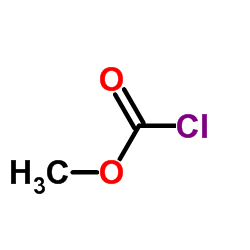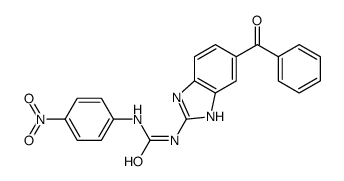Mebendazole

Mebendazole structure
|
Common Name | Mebendazole | ||
|---|---|---|---|---|
| CAS Number | 31431-39-7 | Molecular Weight | 295.293 | |
| Density | 1.4±0.1 g/cm3 | Boiling Point | N/A | |
| Molecular Formula | C16H13N3O3 | Melting Point | 288.5°C | |
| MSDS | Chinese USA | Flash Point | N/A | |
| Symbol |

GHS07 |
Signal Word | Warning | |
Use of MebendazoleMebendazole is a highly effective, broad-spectrum antihelmintic indicated for the treatment of nematode infestations; has been found as a hedgehog inhibitor. |
| Name | mebendazole |
|---|---|
| Synonym | More Synonyms |
| Description | Mebendazole is a highly effective, broad-spectrum antihelmintic indicated for the treatment of nematode infestations; has been found as a hedgehog inhibitor. |
|---|---|
| Related Catalog | |
| References |
| Density | 1.4±0.1 g/cm3 |
|---|---|
| Melting Point | 288.5°C |
| Molecular Formula | C16H13N3O3 |
| Molecular Weight | 295.293 |
| Exact Mass | 295.095703 |
| PSA | 84.08000 |
| LogP | 2.83 |
| Index of Refraction | 1.703 |
| Storage condition | 0-6°C |
CHEMICAL IDENTIFICATION
HEALTH HAZARD DATAACUTE TOXICITY DATA
MUTATION DATA
|
| Symbol |

GHS07 |
|---|---|
| Signal Word | Warning |
| Hazard Statements | H302 |
| Precautionary Statements | P301 + P312 + P330 |
| Personal Protective Equipment | dust mask type N95 (US);Eyeshields;Gloves |
| Hazard Codes | Xn:Harmful |
| Risk Phrases | R22 |
| Safety Phrases | S36 |
| RIDADR | UN 2811 |
| WGK Germany | 3 |
| RTECS | EY8600000 |
| HS Code | 2933990090 |
|
~% 
Mebendazole CAS#:31431-39-7 |
| Literature: Indian Journal of Chemistry, Section B: Organic Chemistry Including Medicinal Chemistry, , vol. 24, p. 948 - 951 |
|
~% 
Mebendazole CAS#:31431-39-7 |
| Literature: Indian Journal of Chemistry, Section B: Organic Chemistry Including Medicinal Chemistry, , vol. 24, p. 948 - 951 |
| HS Code | 2933990090 |
|---|---|
| Summary | 2933990090. heterocyclic compounds with nitrogen hetero-atom(s) only. VAT:17.0%. Tax rebate rate:13.0%. . MFN tariff:6.5%. General tariff:20.0% |
|
Cheminformatics analysis of assertions mined from literature that describe drug-induced liver injury in different species.
Chem. Res. Toxicol. 23 , 171-83, (2010) Drug-induced liver injury is one of the main causes of drug attrition. The ability to predict the liver effects of drug candidates from their chemical structures is critical to help guide experimental... |
|
|
Translating clinical findings into knowledge in drug safety evaluation--drug induced liver injury prediction system (DILIps).
J. Sci. Ind. Res. 65(10) , 808, (2006) Drug-induced liver injury (DILI) is a significant concern in drug development due to the poor concordance between preclinical and clinical findings of liver toxicity. We hypothesized that the DILI typ... |
|
|
Developing structure-activity relationships for the prediction of hepatotoxicity.
Chem. Res. Toxicol. 23 , 1215-22, (2010) Drug-induced liver injury is a major issue of concern and has led to the withdrawal of a significant number of marketed drugs. An understanding of structure-activity relationships (SARs) of chemicals ... |
| mebenvet |
| Methyl (5-benzoyl-1H-benzo[d]imidazol-2-yl)carbamate |
| telmin |
| Methyl-[5-(phenylcarbonyl)-1H-benzimidazol-2-yl]carbamat |
| Methyl [5-(Benzoyl)benzimidazol-2-yl]carbamate |
| lomper |
| Carbamic acid, N-(5-benzoyl-1H-benzimidazol-2-yl)-, methyl ester |
| 5-benzoyl-2-benzimidazolecarbamic acid methyl ester |
| besantin |
| Mebendazole |
| Methyl 5-benzoyl benzimidazole-2-carbamate |
| EINECS 250-635-4 |
| Mebex |
| MFCD00057872 |
| Vermox |
| 5-benzoyl-1H-benzimidazol-2-yl carbamic acid methyl ester |
| mbdz |
| [5-(phénylcarbonyl)-1H-benzimidazol-2-yl]carbamate de méthyle |
| Methyl (5-benzoyl-1H-benzimidazol-2-yl)carbamate |
| bantenol |
| noverme |



![methyl 2-amino-6-benzoyl-1H-benzo[d]imidazole-1-carboxylate structure](https://image.chemsrc.com/caspic/072/104663-13-0.png)
 CAS#:60254-95-7
CAS#:60254-95-7![2-Amino-5(6)-[α-hydroxybenzyl]benzimidazole structure](https://image.chemsrc.com/caspic/247/75501-05-2.png) CAS#:75501-05-2
CAS#:75501-05-2 CAS#:89597-93-3
CAS#:89597-93-3
